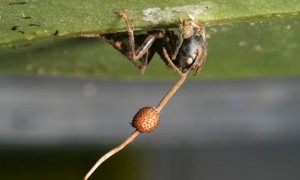Of late, Zombies have become a popular subject for film and television shows. The shows feature the gruesome former humans, stumbling mindlessly around with no apparent goal in mind, infecting all they come across, in brilliant sci-fi dramas. But to the Camponotus leonardi, a species of carpenter ant in Thailand, zombification is hardly science fiction at all. TheOphiocordyceps unilateralis, a fungus that inhabits these ants’ rainforest homes, has the ability to infect these ants, taking over their bodies and creating what has been dubbed, the Zombie Ant.
For the O. unilateralis fungus to thrive, it must live in an environment which adheres strictly to certain conditions; correct humidity, temperature, light, and location to the ground. But the fungus by itself is immobile. It possesses no sort of limbs with which to drive itself to its ideal location to live and produce spores, the underside of leaves just feet off the forest floor. Therefore, the fungus must enlist the help of some mobile creature to transport it, whether voluntary, or not. The unlucky escort of the fungus is the Camponotus leonardi, the Thai carpenter ant.
The Carpenter ants live high in the canopy of Thailand’s rainforests, well above the low ideal breeding places of O. unilateralis. But on occasion, the ants must venture down on top of the canopy in search of food. During their excursion out of the canopy, usually to the forest floor, some ants come into contact with, and become infected by the O. unilateralis fungus. For a short while, the ants are seemingly unaffected by the parasite, but it soon begins to grow inside their heads. The fungus grows inside the skull of its victim. It grows around the brain, taking control, and releasing chemicals which affect the behavior of the ant. The Carpenter ants usually follow each other in neat trails, dictated by a pheromone trail left by the leading ants, but the infected ants are unable to follow in a straight line. They stagger around as if intoxicated. Most often, as is the goal of the fungus, the ant will stagger completely off its leaf and plummet to the foliage far below. Down there is where the fungus will thrive.
Down in the lower foliage, the fungus in the ant’s head is actually able to dictate the specific height of the leaves it wants the ant to go to. The ant obligingly crawls to the leaf which will soon become its grave. When the fungus has completely taken over the ant, it commands it crawl around to the underside of the leaf, and bite into the main vein of the plant. The fungus causes the ant to squeeze its mandibles tight and locks them, preventing the ant from letting go and falling from the leaf. The fungus then proceeds to drain its host of all the calcium in its body, inducing a condition not so different from rigor mortis. The ant dies.
Here, on the underside of a leaf, a short distance off the forest floor is where the fungus will grow. At exactly high noon, the fungus sprouts out of the ant’s head. It grows until nightfall, at which time it releases its spores. The spores fall to the ground, ready to infect a new batch of ants.
With a process containing so many variables, one wonders how long it will take before the fungus will beging to mutate. Could it evolve enough to begin infecting higher life forms? Is it really possible that one day human brains could be taken over by this horrifying parasite?


I really enjoyed this article. It is really interesting to think about the ways the Ophiocordyceps unilateralis takes over the carpenter ant’s brain. I also had another thought: does the fungus have brain activity, or is it merely wired to take over the nts? In addition-would the ability to destroy this fungus harm the ecosytem, or wouls it be beneficial for future ploblems with the fungus? http://dailyorganism.blogspot.com/2011/11/ophiocordyceps-unilateralis.html